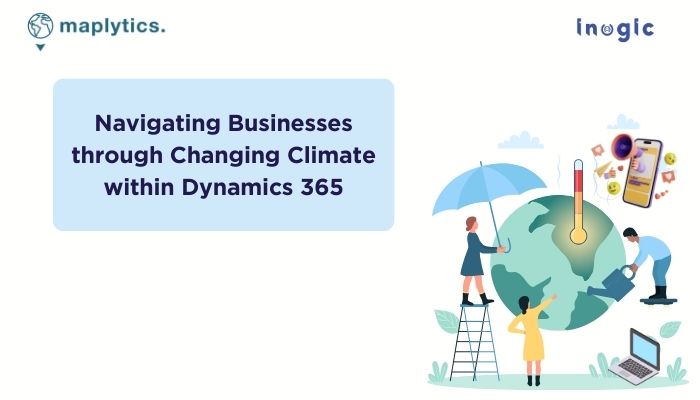“The rate of sea level rise has accelerated in recent decades, with an average increase of 8 inches since 1880.”
Climate change is no longer a distant threat; it’s a pressing reality impacting businesses worldwide. From rising sea levels and extreme weather events to disruptions in supply chains and resource availability, the consequences are far-reaching. To survive and thrive in this new normal, businesses need innovative solutions to adapt and mitigate the business impact of climate change. This is where Maplytics, a popular and powerful geo-mapping and data analytics tool, emerges as a valuable ally.
Business Impact of Climate Change:
Climate change presents a complex web of challenges for businesses:
- Supply Chain Disruptions: Extreme weather events like unprecedented floods, hurricanes, and droughts can disrupt transportation networks and damage infrastructure, leading to shortages of raw materials and delays in product delivery.
- Real Estate Risks: Rising sea levels and flooding threaten coastal properties and infrastructure, impacting business operations and potentially causing damage and relocation costs.
- Resource Scarcity: Changes in weather patterns can affect water availability, agricultural yields, and energy production, impacting resource security and potentially increasing costs.
- Operational Challenges: Heatwaves and extreme weather events can disrupt worker productivity and safety, especially for outdoor or physically demanding jobs.
- Regulatory Landscape: As governments implement stricter environmental regulations, businesses may face compliance costs and potential restrictions on operations.
These challenges can significantly impact an organization’s bottom line, reputation, and long-term sustainability.
Maplytics: A helpful resort for Climate Resilience:
Maplytics, integrated with Dynamics 365, offers a robust toolkit to help businesses navigate the complexities of climate change:
- Risk Assessment and Planning: By leveraging geospatial data and analytics, Maplytics can help identify areas vulnerable to flooding, storms, or other climate-related threats using Heat Map Analysis. This allows businesses to assess potential risks to their facilities, supply chains, and workforce, enabling proactive planning and mitigation strategies by visualizing the analytical data differentiated by color intensity.
- Supply Chain Optimization: Maplytics can analyze historical weather patterns and predict potential disruptions using Dynamics 365 CRM data. Businesses can use this information to diversify their supplier base across geographically dispersed locations, minimizing the impact of localized extreme weather events. Additionally, the route optimization feature can help reduce transportation emissions, contributing to environmental sustainability by providing the shortest routes and navigation directions.
- Resource Management: Advanced analytics capabilities in Maplytics allow businesses to monitor water usage, analyze agricultural land and its health, and optimize energy consumption based on weather patterns. This data-driven approach can lead to more efficient resource utilization and reduced environmental impact.
- Remote Workforce Management: For businesses with a geographically dispersed workforce, Maplytics can track frontline worker locations in real time. This becomes crucial during extreme weather events, allowing managers to ensure worker safety and implement emergency response plans effectively.
Real-World Applications of Maplytics
Here are some examples of how businesses could apply Maplytics to tackle climate challenges:
- Energy Supply: If a utility company utilizes Maplytics to analyze historical weather patterns and predict storm paths, it would allow them to pre-position repair crews and resources in areas most likely to be affected by power outages, minimizing downtime and customer disruption.
- Agriculture Firm: An agricultural company could use Maplytics to monitor the pattern of soil moisture levels and predict potential droughts. This information would allow them to optimize irrigation practices, conserve water resources, and improve crop yields even during dry seasons.
- Construction Company: A construction company could leverage Maplytics to identify floodplains and areas prone to landslides based on Dynamics CRM records. This knowledge could help them select safer locations for development projects and implement necessary mitigation measures during construction.
These are just a few possibilities, and the potential applications of Maplytics in climate adaptation could be vast.
Collaborate to Sustain
While Maplytics provides valuable features, climate change requires a collective effort. Businesses can collaborate with government agencies, environmental organizations, and other stakeholders to share data and adopt best practices. Maplytics’ data visualization can facilitate knowledge sharing and collaboration, enabling businesses to develop a more comprehensive understanding of climate risks and implement effective solutions.
Empowering Businesses to Thrive
The business impact of climate change is undeniable. However, businesses are not powerless. By embracing innovative solutions like Maplytics within Dynamics 365, companies can gain valuable insights, build resilience, and navigate the challenges of a changing climate. Maplytics empowers businesses to not only adapt but also thrive in a new environmental reality or the new normal, ensuring long-term sustainability and success.
The possibilities are endless!
What’s More?
Maplytics is like water that can be moulded into any role. To get more acquainted and experience it first-hand, one can write to crm@inogic.com To investigate the product further, with a personalized demo within Microsoft Dynamics 365 CRM / Dataverse get in touch with the Team.
For applied knowledge, do visit our Website or Microsoft AppSource. One can hop on to the detailed Blogs, Client Testimonials, Success Stories, Industry Applications, and Video Library for a quick query resolution.
Until then,
Happy Mapping!





